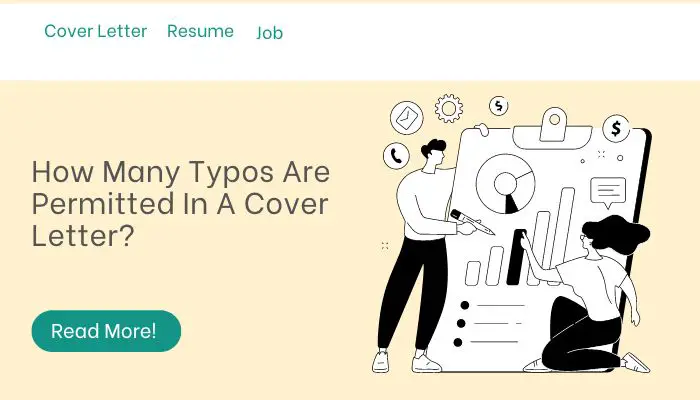A cover letter is a short, one- to two-page document that accompanies your resume when applying for a job. The purpose of the letter is to introduce yourself and explain why you are interested in the position.
In this article, we’ll discuss everything you need to know about writing a great cover letter and answer some common questions. We will also talk about how many typos are permitted on a cover letter, who needs to see it, how long it should be, and much more!
| Takeaways |
|---|
| Proofread your cover letter carefully to avoid errors that can impact your chances of being hired. |
| While one or two minor typos may be forgivable, multiple errors can significantly reduce the effectiveness of your cover letter. |
| A cover letter is a crucial part of a job application and allows you to showcase your skills, qualifications, and interest in the position. |
| To craft a compelling cover letter, make sure to include an introduction, a brief overview of your qualifications, and a conclusion that expresses your interest in the job. |
| Tailor your cover letter to the specific job and company you’re applying to for the best results. |
Should You Use A Cover Letter Template?
Cover letter templates are a useful tool to get started with your cover letter. They can help you to convey the right information in the right way, which is essential for making an impression on your potential employer.
Use a template if
You want to make sure that you are addressing the right information about yourself and/or your experience in connection with this job opening;
You want to make sure that you are making the best possible impression on an employer by highlighting any relevant skills or accomplishments; and/or
You want to make sure that your cover letter follows an appropriate format (as many employers have specific preferences).
Understanding how cover letters work is crucial in crafting an effective job application. To learn more about the elements that make up a strong cover letter, check out our comprehensive guide on how cover letters work in job applications.
Are Cover Letters Necessary?
Cover letters are a great way to introduce yourself to potential employers, especially if you’re applying for a job that has not been advertised. They are also useful if you don’t have an extensive work history and want to make your resume stand out from all the other applicants.
Cover letters can be used to explain why you would be perfect for the position, or even demonstrate your knowledge about the company’s mission and culture think of them as an opportunity for you to showcase yourself as someone who values quality over quantity.
What Are The Different Types Of Cover Letters?
There are several types of cover letters, which can be categorized based on the level of formality and length.
A generic cover letter is generally used for all job applications and does not include any details about the position being applied for. A targeted cover letter, however, includes information about your skills and experience that make you a good fit for a specific position.
A cold call cover letter is similar to a targeted cover letter in that it focuses on your relevant skills and experience; however, cold call letters also include an element of surprise as they use unconventional methods (such as responding to an advertisement or sending unsolicited applications) to get noticed by potential employers.
Warm letters are similar to cold calls in their intent; however warm letters tend towards slightly more personal touches like handwritten notes or phone calls when applying for jobs via email or online application forms
Crafting a cover letter that showcases your skills and qualifications can be challenging. To ensure that you have all the information you need to create a standout cover letter, check out our ultimate guide on all you need to know about cover letters.
Who Needs To See A Cover Letter?
Though you may not think it, people outside the hiring manager need to see your cover letter. The following people also need to read your cover letter:
- The recruiter
- HR department
- Hiring the manager’s boss (and his/her boss)
How Many Typos Are Permitted On A Cover Letter?
If you have one or two typos, it’s okay. You can get away with a few mistakes here and there, but generally speaking, less is more. If you make three or more typos on your cover letter, then it might be time to redo the whole thing.
If you have several grammatical errors in your cover letter (including spelling mistakes), the hiring manager may think that this shows that you lack attention to detail or care about their business.
Should Your Cover Letter Include Color And Design Elements?
Cover letters are often accompanied by design elements like color and layout. But how much is too much?
If you want to use color, it’s best to keep things simple. A single block of an accent color can help draw the reader’s attention to a certain section of your letter.
Just don’t go overboard: Keep in mind that your resume will likely be printed on paper that’s white or off-white, so if your cover letter is full of bright yellow, orange, green and red hues it’ll look terrible when it gets printed out.
You also don’t have to worry about using any fancy fonts or layouts because most modern applications will automatically format them for you before sending them off (more on that later).
How Should You Sign Off On A Cover Letter?
A cover letter is a formal business letter, so it’s best to use the same conventions as any other formal business letter: Use your name, not “Sincerely” or “Best regards.” And don’t use an emoticon or smiley face!
Your cover letter should end with a colon and then your name. For example Jane Doe
If you’re mailing your application or resume to multiple people within one company, including each person’s name on their line before signing off. For example Dear Ms. Smith and Mr. Jones
If you are sending out your application materials by email to multiple people at the same organization, it’s best not to attach them all; instead send each recipient his/her copy of the cover letter and attachments (resume, references).
A well-written cover letter can be the difference between landing an interview or being passed over for a job. For tips on crafting a cover letter that grabs the attention of hiring managers, check out our guide on how effective cover letters are in job applications.
What Is A Good Length For A Cover Letter?
A good rule of thumb is to keep the letter at two to three paragraphs. A one-page cover letter is ideal, but if it’s longer than that, don’t worry about it! If you find yourself writing more than one page, just take a step back and make sure that your paragraphs are all related and focused on the same point.
It’s also important to remember that this document should be written in a conversational tone just like you would any other email or letter you’d send out.
The cover letter is often the first impression that a potential employer has of you, making it an essential part of your job application. To learn more about the importance of cover letters in landing a job, check out our expert advice on how necessary cover letters are in today’s job market.
Is It Still Necessary To Address Your Cover Letter To The Hiring Manager Or Recruiter?
It is still necessary to address your cover letter to the hiring manager or recruiter. This shows that you have done your research and are serious about the job. It also shows that you have read the job description and understand what they expect from you, which is always a good sign when looking for work.
While some job postings may not require a cover letter, it’s important to consider the benefits of including one in your application. To learn more about why cover letters are important, check out our guide on the importance of cover letters in landing a job.
Conclusion
In the end, it’s important to remember that your cover letter is a tool for getting an interview. The most important thing you can do is make sure that it reflects your personality and background in a way that makes you stand out from the crowd of applicants.
If you have any questions about how to write or format your cover letter, we recommend checking out these resources:
Further reading
How many typos before you trash a resume?: Learn about the impact of typos on resumes and how many mistakes are too many for hiring managers.
Cover letter study guide flashcards: A useful study guide on the essential elements of a cover letter and how to craft a compelling one.
Do typos in a cover letter matter?: This article explores the importance of proofreading and the impact of typos in a cover letter on a job application.
FAQs
What is a cover letter?
A cover letter is a document that accompanies a job application and highlights a candidate’s qualifications and interest in the position.
How important is a cover letter in a job application?
A cover letter is a crucial part of a job application, as it allows candidates to showcase their skills, qualifications, and interest in the position.
How many typos are acceptable in a cover letter?
While it’s best to avoid typos altogether, one or two minor errors may be forgivable. However, multiple typos can significantly impact the effectiveness of a cover letter and reduce a candidate’s chances of being hired.
How do I proofread my cover letter effectively?
To proofread your cover letter effectively, read it slowly and carefully, line by line. You can also try reading it out loud to catch errors that your eyes might miss. It’s also helpful to have someone else read it over for you.
What should I include in my cover letter?
Your cover letter should include an introduction, a brief overview of your qualifications, and a conclusion that expresses your interest in the position and gratitude for the opportunity to apply. It should also be tailored to the specific job and company you’re applying to.

Costantine Edward is a digital marketing expert, freelance writer, and entrepreneur who helps people attain financial freedom. I’ve been working in marketing since I was 18 years old and have managed to build a successful career doing what I love.
